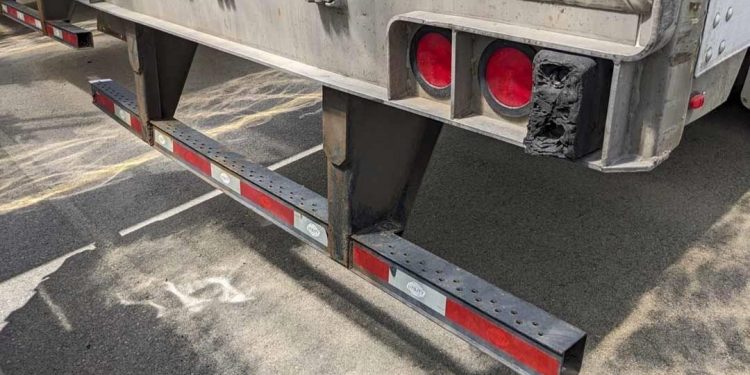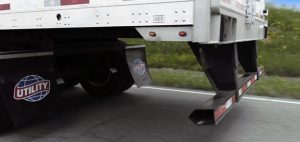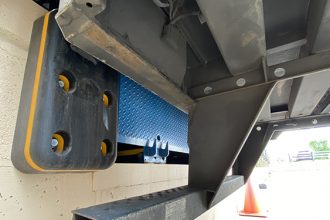How Rear Impact Guard Regulation and Design Changes Affect Loading Dock Safety

A Rear Impact Guard (RIG), also known as an ICC bumper, helps prevent closely following passenger cars from riding under the rear of a semi-trailer if it must stop quickly from a high speed.
The position and durability of a trailer’s RIG is important not only from the perspective of someone following it in a passenger vehicle, but also to anyone loading or unloading the trailer with a forklift at the loading dock. This makes it important to stay informed of changes to RIG safety standards and new RIG designs.
Updated DoT Safety Standards for Rear Impact Guards
As of December 9, 2021, the Federal Motor Carrier Safety Administration (FMCSA) requires RIGs to be included in annual commercial motor vehicle inspections. This means that applicable vehicles with RIGs can no longer pass annual inspection with a damaged or missing RIG.
Trailers with a gross vehicle weight rating of at least 10,001 lbs. manufactured on or after January 26, 1998, can’t pass inspection for any of these reasons:
- Missing RIG.
- RIG not securely attached to trailer, including broken or missing fasteners, cracked welds or parent metal, or any other damage that compromises attachment.
- RIG horizontal bar does not extend to within four inches of each side extremity of the vehicle or extends beyond each side extremity.
- RIG horizontal bar is more than 22 inches above the ground.
- RIG horizontal bar is more than 12 inches forward of the rear extremity of the vehicle.
- Full length of RIG horizontal bar does not have a cross sectional vertical height of at least four inches.
Commercial motor vehicles manufactured between December 31, 1952, and January 26, 1998 can’t pass inspection for any of these reasons:
- Missing RIG.
- RIG not securely attached to trailer by bolts, welding, or other comparable means.
- RIG horizontal bar is more than 30 inches above the ground.
- RIG horizontal bar does not extend to within 18 inches of each side extremity of the vehicle.
- RIG horizontal bar is more than 24 inches forward of the rear extremity of the vehicle.*
In addition, the National Highway Traffic Safety Administration (NHTSA) has adopted similar underride protection requirements to Transport Canada’s standard for RIGs. As of January 11, 2023 the NHTSA requires new trailers and semitrailers with a gross vehicle weight rating of at least 10,000 lbs. to be equipped with a RIG that provides sufficient strength and energy absorption to protect occupants of compact and subcompact passenger cars impacting the rear of a trailer at 35 mph.**
New RIG designs
Seemingly in conjunction with these regulatory changes is the emergence of a new pentagonal RIG design, like the example pictured from Utility.

This new RIG design features a 5-sided pentagonal horizontal bar rather than the traditional 4-sided square or rectangle, and the inside face of the horizontal bar comes to a point rather than a flat surface. Utility says this new RIG has a horizontal bar depth measurement of 7” and exceeds U.S. Department of Transportation and Transport Canada regulations.***
This new-style RIG has also been seen on some Great Dane trailers, and because they exceed regulatory standards, it’s likely we’ll continue to see them on more trailers around North America over time.
There are three main benefits of a RIG that exceeds safety standards. It should:
- Provide enhanced underride protection.
- Increase a trailer’s ability to pass annual CMV inspections over time.
- Help prevent early trailer separation from the loading dock.
It makes sense that a stronger RIG will be more likely to succeed in preventing underride situations. It also makes sense that a stronger RIG is more likely to withstand damage and environmental wear, which means it’s less likely to be the reason a trailer may not pass annual inspection after years of service.
When the trailer is backed up to a loading dock, it’s very common the facility is equipped with a vehicle restraint designed to engage that trailer’s RIG and secure the trailer to the dock.
Therefore, the enhanced strength of the RIG also makes it more likely to hold up under pressure at the loading dock if a driver ignores visual communication signals and attempts to leave before the vehicle restraint has been disengaged. This can help prevent a gap from forming between the trailer and the dock, causing the dock leveler lip to fall and creating a possible danger to personnel.
But the new pentagonal RIG design comes with a caveat. This design was introduced without collaboration of the industry’s Loading Dock Equipment Manufacturers (LODEM) or the customers they serve. Vehicle restraints were previously designed to secure RIGs by their relatively square surface because that’s how RIGs were designed for many years. Once the new pentagonal design started to appear in the market, members of LODEM expressed concerns to the Truck Trailer Manufacturers Association (TTMA) that new trailer RIG designs, such as the 5-sided pentagonal design, might negatively impact the effectiveness of many vehicle restraints already installed at loading docks throughout North America. However, members of TTMA decided to move forward with these new trailer designs.
This makes it important for facility managers and owners to monitor the types of trailers visiting their docks, so they can ensure their vehicle restraints can safely accommodate the widest variety of RIGs. In addition, those managers/owners with in-house fleets should insert themselves into the selection of the type of RIG options available for the trucks they’re using.
This appears to be happening as evidence of recent pentagonal modifications where a “flat” surface is introduced in the center of the RIG bar to accommodate a greater variety of restraints currently in use. LODEM manufacturers are also evaluating the variety of new trailer RIG designs and have been adjusting their vehicle restraints to effectively accommodate these new 5-sided pentagonal RIGs.
Like any equipment, trailer RIG designs will continue to evolve over time. Trailer manufacturers could make additional changes that may further impact how their trailers interact with existing vehicle restraints. LODEM will continue to advocate for safety at the loading dock. Facility owners must stay up to date on these changes to ensure they have a thorough safety solution that can secure the widest variety of RIGs on trailers that they service.
For more information about this topic, register for LODEM’s webinar here: https://attendee.gotowebinar.com/register/6683366464964972123
For more information about LODEM, please visit their site: https://www.mhi.org/lodem
Sources: *https://landline.media/with-the-new-inspection-regs-is-your-rear-impact-guard-compliant
**https://www.federalregister.gov/documents/2022/07/15/2022-14330/federal-motor-vehicle-safety-standards-rear-impact-guards-rear-impact-protection
***https://www.businesswire.com/news/home/20210128005918/en/Utility-Implements-Standard-7%E2%80%99%E2%80%99-Rear-Impact-Guard-on-All-Trailer-Models



